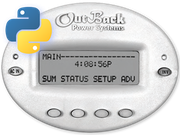pyMATE is a python library that can be used to emulate an Outback MATE unit, and talk to any supported Outback Power Inc. device such as an MX charge controller, an FX inverter, a FlexNET DC monitor, or a hub with multiple devices attached to it.
You will need a simple adapter circuit and a TTL serial port. For more details, see jared.geek.nz/pymate
To see the library in action, check out my post on connecting it with Grafana! jared.geek.nz/grafana-outback-solar
- outback_mate_rs232 - For use with the Mate's RS232 port
- uMATE - Companion Arduino library, featuring more reliable communication and better perf
To set up communication with an MX charge controller:
mate_bus = MateNET('COM1') # Windows
mate_bus = MateNET('/dev/ttyUSB0') # Linux
mate_mx = MateMXDevice(mate_bus, port=0) # 0: No hub. 1-9: Hub port
mate_mx.scan() # This will raise an exception if the device isn't foundOr to automatically a hub for an attached MX:
bus = MateNET('COM1', supports_spacemark=False)
mate = MateMXDevice(bus, port=bus.find_device(MateNET.DEVICE_MX))
# Check that an MX unit is attached and is responding
mate.scan()You can now communicate with the MX as though you are a MATE device.
You can query a status with mate_mx.get_status(). This will return an MXStatusPacket with the following information:
status = mate_mx.get_status()
status.amp_hours # 0 - 255 Ah
status.kilowatt_hours # 0.0 - 6553.5 kWh
status.pv_current # 0 - 255 A
status.bat_current # 0 - 255 A
status.pv_voltage # 0.0 - 6553.5 V
status.bat_voltage # 0.0 - 6553.5 V
status.status # A status code. See MXStatusPacket.STATUS_* constants.
status.errors # A 8 bit bit-field (documented in Outback's PDF)All values are floating-point numbers with units attached. You can convert them to real floats with eg. float(status.pv_voltage) # 123.4, or display them as a human-friendly string with str(status.pv_voltage) # '123.4 V'
You can also query a log page (just like you can on the MATE), up to 127 days in the past: (Logpages are stored at midnight, 0 is the current day so far)
logpage = mate_mx.get_logpage(-1) # Yesterday's logpage
logpage.bat_max # 0.0 - 102.3 V
logpage.bat_min # 0.0 - 102.3 V
logpage.kilowatt_hours # 0.0 - 409.5 kWh
logpage.amp_hours # 0 - 16383 Ah
logpage.volts_peak # 0 - 255 Vpk
logpage.amps_peak # 0.0 - 102.3 Apk
logpage.absorb_time # 4095 min (minutes)
logpage.float_time # 4095 min
logpage.kilowatts_peak # 0.000 - 2.047 kWpk
logpage.day # 0 .. -127Additionally, you can query individual registers (just like you can on the MATE - though it's buried quite deep in the menus somewhere)
mate_mx.charger_watts
mate_mx.charger_kwh
mate_mx.charger_amps_dc
mate_mx.bat_voltage
mate_mx.panel_voltage
mate_mx.status
mate_mx.aux_relay_mode
mate_mx.max_battery
mate_mx.voc
mate_mx.max_voc
mate_mx.total_kwh_dc
mate_mx.total_kah
mate_mx.max_wattage
mate_mx.setpt_absorb
mate_mx.setpt_floatNote that to read each of these properties a separate message must be sent, so it will be slower than getting values from a status packet.
To set up communication with an FX inverter:
mate_bus = MateNET('COM1') # Windows
mate_bus = MateNET('/dev/ttyUSB0') # Linux
mate_fx = MateDCDevice(bus, port=bus.find_device(MateNET.DEVICE_FX))
mate_fx.scan()
status = mate_fx.get_status()
errors = mate_fx.errors
warnings = mate_fx.warningsYou can control an FX unit like you can through the MATE unit:
mate_fx.inverter_control = 0 # 0: Off, 1: Search, 2: On
mate_fx.acin_control = 0 # 0: Drop, 1: Use
mate_fx.charge_control = 0 # 0: Off, 1: Auto, 2: On
mate_fx.aux_control = 0 # 0: Off, 1: Auto, 2: On
mate_fx.eq_control = 0 # 0: Off, 1: Auto, 2: OnThese are implemented as python properties, so you can read and write them. Writing to them affects the FX unit.
WARNING: Setting inverter_control to 0 WILL cut power to your house!
There are a bunch of interesting properties, many of which are not available from the status packet:
mate_fx.disconn_status
mate_fx.sell_status
mate_fx.temp_battery
mate_fx.temp_air
mate_fx.temp_fets
mate_fx.temp_capacitor
mate_fx.output_voltage
mate_fx.input_voltage
mate_fx.inverter_current
mate_fx.charger_current
mate_fx.input_current
mate_fx.sell_current
mate_fx.battery_actual
mate_fx.battery_temp_compensated
mate_fx.absorb_setpoint
mate_fx.absorb_time_remaining
mate_fx.float_setpoint
mate_fx.float_time_remaining
mate_fx.refloat_setpoint
mate_fx.equalize_setpoint
mate_fx.equalize_time_remainingTo set up communication with a FLEXnet DC power monitor:
mate_bus = MateNET('COM1') # Windows
mate_bus = MateNET('/dev/ttyUSB0') # Linux
mate_dc = MateDCDevice(bus, port=bus.find_device(MateNET.DEVICE_FLEXNETDC))
mate_dc.scan()
status = mate_dc.get_status()The following information is available through get_status():
- State of Charge (%)
- Battery Voltage (0-80V, 0.1V resolution)
- Current kW/Amps for Shunts A/B/C
- Current kW/Amps for In/Out/Battery (Max +/-1000A, 10W/0.1A resolution)
- Daily kWH/Ah for Shunts A/B/C & In/Out/Battery/Net
- Daily minimum State of Charge
- Days since last full charge (0.1 day resolution)
You can manually reset daily accumulated values by writing to certain registers, but this is not yet implemented.
For convenience, a simple server is included that captures data periodically and uploads it to a remote server via a REST API. The remote server then stores the received data into a database of your choice.
The default serial interface doesn't always work well, and it's not the most efficient, so there is an alternative protocol you can use which pipes the data to an Arduino via PJON protocol.
To use this alternative protocol:
port = MateNETPJON('COM1')
bus = MateNET(port)See this page in my uMATE project for an example bridge implementation.
For details on the low-level communication protocol and available registers, see doc/protocol/Protocol.md
I am open to contributions, especially if you can test it with any devices I don't have.
